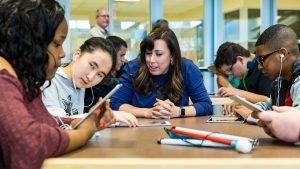Apple’s Commitment to Making its Hardware and Software Accessible for All
COMMENTARY: 05.25.18— Apple has one stake to claim that most other technology companies can’t. Ensuring that all of its products from hardware to software are fully accessible to everyone right out of the box.
I read a press release from Apple last week on how it is making coding available to students who are deaf and blind.

From the press release:
“The schools will tailor lessons using Apple’s groundbreaking accessibility technology which has changed the lives of millions of people with vision, hearing, physical motor, cognitive, or other assistive needs.
The partnership was announced on May 17, the same day as Global Accessibility Awareness Day. In recognition of the event, Apple hosted events worldwide in order to promote inclusive design and emphasize how technology can support all people with disabilities.
This caught my attention and intrigued me because for one thing, it’s about Apple and technology, but for another reason you may not yet know (unless you have read some of my stories).
I am visually impaired and have been totally blind since 2013.
You wouldn’t know this from reading my stories online or from a photograph of me because I look totally normal since I was not born blind. And I am still able to function pretty normally technology-wise, as far as my Apple devices go, like I did when I still could see thanks to Apple’s commitment to those with disabilities.
Specifically for the visually impaired, Apple has VoiceOver, a built-in software included with iOS and Mac OS that speaks out loud everything on the screen from text to buttons. It allows anyone from low vision or no vision at all (like myself) to use their Apple products with hardly any assistance at all. And best of all? It’s absolutely free!
Windows PCs do not have this functionality built-in to the operating system and I was told by my assistive technology instructor, who was teaching me to use VoiceOver with Mac OS, that similar third party software costs upwards of $1,000. And if you have a mobile device that isn’t from Apple, say Android, there is a similar screen reader software available for those devices but the functionality differs from that of third party software on the Windows platform.
With Apple, as with all of the products in its ecosystem, everything works seamlessly across the board and generally in the same way.
However, I have found it much easier to do my computer work on iOS using VoiceOver than it is to do it using Mac OS because of the nature of the touch-based interface. It is more intuitive and easier to navigate in the iOS environment than the Mac OS and thus, my primary “computers” these days are my iPhone SE with a folding mobile keyboard and my iPad mini 4 permanently attached to a Zagg keyboard portfolio case. I still have my three computers — a MacBook Pro 15-inch Late 2008, an iMac 20-inch Early 2009, and a MacBook Air 11-inch Mid-2011 — which I use from time to time but these days, they have taken a back seat to my iOS devices.
I cannot tell you how much Apple technology has helped me to live a normal life. I am able to communicate with family and friends via text message or phone, interact on social media platforms like FaceBook and LinkedIn, or browse the internet and access practically all my iOS apps even though I can no longer see the screen. I’ve even ordered take out for delivery or gone grocery shopping and had my list of items delivered to my door.
And the ability to continue my writing career and bring you stories like these is an added plus. Without Apple’s VoiceOver technology in my bag of tricks, I don’t know where I’d be today.
I ended my almost two decades of my teaching career when I lost my vision but hope to teach again in the future like teaching assistive technology to other blind people of all ages to help them use their Apple products since that is where my expertise and knowledge lies.
In the aforementioned press release, Apple CEO Tim Cook said, “Apple’s mission is to make products as accessible as possible.”
Also in that press release, Julie Tye, president and CEO of the Hadley Institute for the Blind and Visually Impaired said, “As the largest educator within the visually impaired community, Hadley knows firsthand how important Apple’s technology is in making daily living easier and more enjoyable.”
I may be disabled but Apple technology has enabled and empowered me thanks to their commitment to making things accessible for all.
Want to join the conversation? Comment below:
